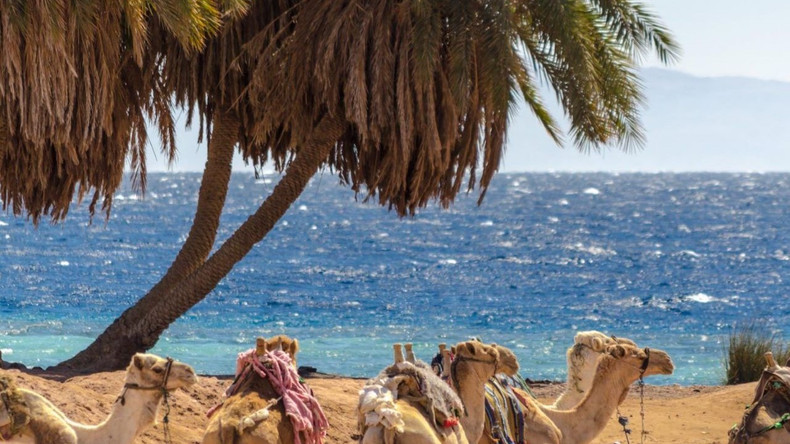The Sinai Peninsula, also known as Sinai, is a landmass in Egypt and the only part of the country situated in Asia. It lies between the Mediterranean Sea to the north and the Red Sea to the south, serving as a land bridge between Asia and Africa. The peninsula covers an area of about 60,000 km2 (23,000 sq mi) and is home to approximately 600,000 people. Administratively, the majority of the Sinai Peninsula is divided into two governorates: the South Sinai Governorate and the North Sinai Governorate. Additionally, three other governorates cross the Suez Canal, extending into African Egypt: Suez Governorate in the south, Ismailia Governorate in the centre, and Port Said Governorate in the north.
Historically, the region was known as Arabia Petraea. The modern name "Sinai" is derived from the assumption that a mountain near Saint Catherine's Monastery is the Biblical Mount Sinai, a site of great religious significance in the Abrahamic faiths.
The Sinai Peninsula has been part of Egypt since the First Dynasty of ancient Egypt (c. 3100 BC). In contrast, the region to its north, the Levant, has historically been a centre of conflict between Egypt and various states of Mesopotamia and Asia Minor due to its strategic geopolitical location and cultural convergences.
During periods of foreign occupation, the Sinai, like the rest of Egypt, was also controlled by foreign empires, including the Ottoman Empire (1517–1867) and the United Kingdom (1882–1956). Israel occupied Sinai during the Suez Crisis of 1956 and the Six-Day War of 1967. In 1973, Egypt launched the Yom Kippur War, seizing most of the east bank of the Suez Canal and negotiating the rest of Sinai. As a result of the Egypt–Israel peace treaty of 1979, Israel withdrew from the Sinai Peninsula, except for the disputed territory of Taba, which was returned in 1989 following a ruling by a commission of arbitration.
Today, Sinai has become a popular tourist destination due to its natural beauty, vibrant coral reefs, and historical significance.
Geography of Sinai
Sinai is part of the Great Rift Valley, a major fracture in the earth's crust that starts in East Africa and extends through the Red Sea, and the Gulf of Aqaba to the Jordan Valley (Dead Sea and Sea of Galilee).
Sinai stretches 380 km from North to South, is 210 km wide, covering an area of 61,000 km², and has a 600 km coastline.
The northern part of Sinai borders the Mediterranean Sea and Israel. It mainly consists of flat expanses of sand and some agricultural areas. The capital of the North Sinai governorate is El Arish, where most of the northern population resides. The western part of Sinai is bordered by the Gulf of Suez and the Red Sea, known for its oil industry, the Suez Canal, and the Suez Tunnel.
The capital of the South Sinai governorate is El Tur, located on the southwest coast. The eastern part of Sinai is bordered by the Gulf of Aqaba, extending from the northeastern city of Taba, near the Israeli border, to Nuweiba, Dahab, and Sharm el Sheikh in the south. This area is known for its underwater paradise, attracting many visitors.
The central part of Sinai is less visited and consists of a large limestone plateau, the region of El Tih, which serves as the border between North and South Sinai.
The southern part of Sinai features a lunar landscape of granite mountains, including Mount Katherine (2642 m) and Mount Sinai, also known as Mount Horeb or Moses' Mountain (2285 m). This area boasts beautiful landscapes, diverse fauna, and rare flora, and is of historical and cultural significance.
Sinai experiences sudden storms during winter and early spring, leading to floodwaters from the mountains flowing through wadis and channels towards the sea, resulting in an explosion of green plants and waterfalls.
Sinai is fortunate enough to have enough water to support a remarkable diversity of life, with South Sinai witnessing rainfall and flooding since 2010.
The southern part of Sinai is renowned for its underwater world, particularly the Ras Mohamed National Park, which features colourful coral reefs teeming with life and provides excellent conditions for snorkelers, free divers, and scuba divers. With an average of 360 days of sun, it is truly a paradise.
